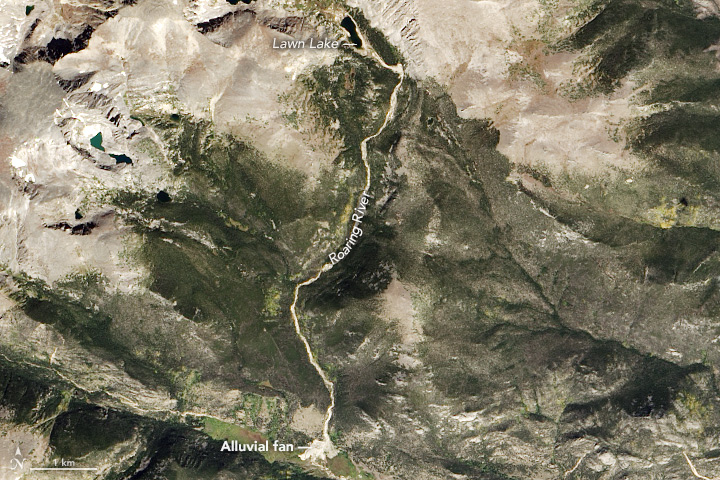


Colorado’s Rocky Mountain National Park presents a very different landscape in summertime than in wintertime. Snow retreats and gives way to blooms of wildflowers, even at high elevations. Roads and trails become accessible, allowing visitors easier access to the rugged mountain trails and vistas.
The diversity of the park’s landscape is visible in this image, acquired on September 20, 2014, with the Operational Land Imager (OLI) on the Landsat 8 satellite. Except for a few patches, seasonal snow is mostly gone. Even the “Never Summer Mountains”—a range along the park’s northwest border known to receive snow any time of year—appears to be temporarily snow-free.
During the short summer season, the alpine tundra ecosystem above 3,300 meters (11,000 feet) appears light brown. This treeless, high-elevation landscape comprises about one-third of the park’s 1,075 square kilometers (415 square miles). Expansive vistas are visible from the Trail Ridge Road, which tops out at 3,713 meters (12,183 feet)—the highest road in any national park.
At a lower elevation of 3,279 meters (10,758 feet), Trail Ridge Road crosses the Continental Divide. Water flowing from the west side drain into the headwaters of the Colorado River; water to the east flows into the Mississippi drainage basin. This mountain spine includes some of the highest mountains in North America and stretches from Alaska to Mexico, passing through Rocky Mountain National Park on the way.
The subalpine zone, between about 2,700 and 3,400 meters (9,000 and 11,000 feet), appears greener. That’s because evergreen trees take root here amid myriad streams and mountain lakes. The second image offers a detailed view of Roaring River, a case study in the tenuous balance between water and rock in these mountains. In 1982, a dam gave way and hundreds of millions of gallons of water moved trees, sand, and boulders downstream. The flood event formed an alluvial fan in the meadow of Horseshoe Park.
NASA Earth Observatory images by Jesse Allen, using Landsat data from the U.S. Geological Survey. Caption by Kathryn Hansen.
Summertime exposes the diversity of landscapes in Rocky Mountain National Park, from the high-elevation alpine tundra to the forested subalpine zone.
Image of the Day for July 19, 2016